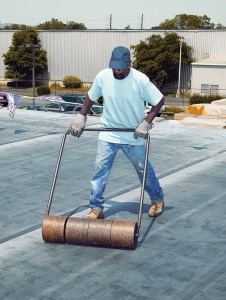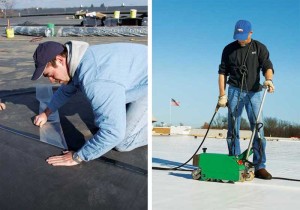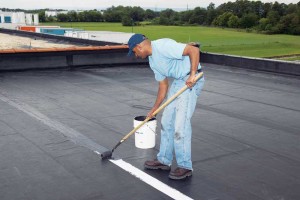Restoring aged EPDM roof assemblies
by Catherine Howlett | February 1, 2013 3:38 pm

by Ron Goodman, MBA
When replacing a roof, it has generally been good practice to tear off the existing assembly and replace it with new material. However, this is beginning to change. Simply getting rid of an older roof may not be the best choice for the building owner or the environment.
Sustainability is fueling the desire of building owners to decrease resource consumption and reduce landfill use. The advent of several forensic diagnostic tools is consistent with the trend of minimizing waste and extending the life of existing materials. Now, more than ever, building owners have multiple options to consider when roof systems need repairing.
To determine the best option for replacing an aged roof, the following technologies are useful:
- infrared and nuclear moisture scans;
- moisture meters;
- fastener pull-out equipment;
- insulation density tests; and
- Global Positioning System (GPS) tools.
When these are used in conjunction with thorough energy analyses and lifecycle costing, the best replacement approach becomes clear. With these technologies, building owners can make informed decisions based on both logic and economics.
These testing methods and technologies could not have come at a better time. Over the past 50 years, ethylene propylene diene monomer (EPDM) single-ply roofs have considerably grown in market share. As a result, there are now many aging EPDM assemblies throughout the United States, and owners will be faced with the task of finding cost-effective, durable solutions to keep them in proper working order without tearing off the existing roofs.
 [1]
[1]Several factors come into play when deciding how to address an EPDM roof at the end of its useful life. These include:
- thermal bridging;
- proper drainage;
- R-value;
- surface color;
- wind uplift; and
- hail resistance.
Other than complete removal or replacement, owners are faced with two primary options: restoration or re-covering.
The former usually encompasses reworking the flashings, seams, and terminations, while leaving the field membrane in place. EPDM is well-known for its long-term weatherability, so in most cases, the field membrane still has life left. This option is primarily used when the owner wants to extend the existing roof’s life or warranty coverage for an additional five to 10 years.
Re-covering the EPDM roof provides the ability to address more issues than a typical restoration. Proper drainage, thermal bridging, enhanced R-value, altered surface color, improved wind uplift, and better hail resistance are all issues better addressed with a roof re-cover. This option typically offers more performance than a roof restoration; in many instances, it can be warranted for terms up to 20 years.
 [2]
[2]Facility owners are considering factors beyond materials when deciding on a new roofing system—aspects such as energy costs, environmental issues, and restoration choices are all important. Each facility should be analyzed for myriad material choices, and need to be looked at with regard to structure type and use. The building’s geographic location (relative to cooling and heating degree days), surrounding buildings, wind, fire, maintenance, and insurance are a few of the basic items that should be considered when determining how to address an aging roof.
EPDM restoration
Restoring single-ply systems can be the most prudent option for a building owner. Its service should not be considered ‘over’ until the usable life of the roof is really finished—many single-ply systems are providing performance well beyond 20 years of age.
When considering restoration options, the membrane type must be taken into account. If a building owner originally selected an economical membrane such as a 1.14-mm (45-mil) sheet, then the restoration process may require a roof coating to extend the product’s life in addition to stripping in the seams and redoing the flashings.
Over the past several years, coating technology has significantly advanced to the point where they are considered a viable solution to an aged, but not failing, assembly. Many feature warranties covering the products’ reflectivity and performance, providing buildings and owners with years of protection and extended service life.
For buildings featuring a thicker, more premium membrane (e.g. 1.5-, 2-, or 2.3-mm [60-, 75-, or 90-mil] sheet), restoration procedures may only have to address the seams and flashings. Coatings can still enhance reflectivity, but in many instances they are not necessary to enhance the field membrane’s performance. The old adage of ‘pay me now or pay me later’ holds true when it comes to the thickness of some roofing materials, and it is encouraging building owners are increasingly recognizing the benefits of thicker membranes.
When redoing seams and flashings, nothing is more important than proper membrane preparation, regardless of thickness. The accepted method for the area to be stripped in is to scrub it using warm water and a low-sudsing soap. After the membrane has been washed, it must be rinsed with clean water and given time to dry. Next, a weathered membrane cleaner and primer coat is applied before installing a cured, pressure-sensitive EPDM cover strip that ultimately waterproofs the seam.
For fully adhered systems with large areas of delamination, the primary restoration procedure involves adhering a reinforced universal securement strip (RUSS) to the existing membrane and then mechanically fastening it at 305 mm (12 in.) on center (oc). It is used in perimeter securement on mechanically fastened, fully adhered, ballasted, and metal retrofit systems, and can also be installed horizontally and vertically with seam-fastening plates below the EPDM deck membrane for additional securement, or in conjunction with gravel stops and edging details. Many contractors favor this option over installing narrow-width perimeter sheets to meet wind-uplift requirements.
 [3]
[3]After installing the fasteners and plates, the upgraded attachment is stripped in with a cured cover strip. For areas with a small amount of delamination, fasteners can be directly installed through the existing sheet and then stripped in with a pressure-sensitive cured EPDM cover strip. For mechanically fastened systems, any loose or tented fasteners should be replaced or re-secured before completing the strip-in process.
While the restoration procedure for ballasted systems is similar to the fully adhered and mechanically attached method, the stone must first be removed from the areas in need of repair. Rakes or shovels should not be used as they can damage the field membrane. A gravel pusher or broom can clear approximately 305 mm of area on each side of the splice. After the splice has been exposed, these same strip-in procedures can be followed.
For large restoration or full recovery projects, many contractors employ an industrial vacuum to efficiently remove ballast from the roofing system, sucking it into a truck or tank on the ground. After large roof areas are re-covered or replaced, the ballast can be reloaded back onto the roof by reversing the vacuum, pumping the ballast back to the rooftop. This method creates less dust and debris within the building and the surrounding environment, while allowing ballast to be easily reused.
 [4]
[4]EPDM roof re-cover
The re-covering option is primarily employed on adhered and mechanically fastened systems, providing the opportunity to address more building issues than a typical restoration. Energy-analysis software reveals most buildings in the United States are under-insulated. (This is reflected by the fact American Society of Heating, Refrigerating, and Air-conditioning Engineers [ASHRAE] 90.1, Energy Standard for Buildings except Low-rise Residential Buildings minimum R-values increased from 15 to 20 in many climate zones when the standard was updated in 2007.) This is important, as the cost of energy has gone up dramatically in the past 10 to 15 years.
Re-cover options afford the opportunity to add more insulation to the rooftop without having to tear off the original material. The insulation can be fastened in place or, in some cases, adhered directly to the existing material with a two-component urethane adhesive. With the recent advancements in insulation product offerings, drainage issues can also be addressed with tapered insulation or crickets before installing the new membrane. The ability to correct ponding water and drainage issues on the roof is a huge advantage of the re-cover option.
Some insulation materials should not be placed between two individual single-ply roof membranes; however, this can be addressed by drilling weep holes through the existing membrane before placing the new insulation. Dewpoint calculations can also be done to determine if there will be an issue. In most cases, the insulation is only added in certain locations to address drainage issues.
Altering a building’s rooftop color is also easier in a re-cover than a restoration. If a structure has a black roof in the South—where there are more cooling degree-days than heating—it makes sense to consider re-covering the system with a white membrane. Conversely, if one has a white roof in the North—where there are more heating degree-days than cooling—a black roof re-cover could be the answer.
The emergence of fleece-backed technology (i.e. a single-ply membrane mated to a fleece material) has advanced the roof re-cover industry. These membranes separate the new from the old, while providing an increase in puncture and hail-damage resistance.
This method has been popular for several years when re-covering asphalt-based roofing assemblies, and the technology has also recently been extended to single-ply systems. In many cases, the existing EPDM membrane can be power-washed, and then a fleece-backed membrane can be adhered directly to the old roof. One can think of this as a two-ply system that provides dual protection, yet is much lighter in weight than many of the alternative multi-ply roofing systems. Fleece-backed membranes are typically available in EPDM, thermoplastic polyolefin (TPO), and polyvinyl chloride (PVC) options of varying thicknesses.
Another option growing in popularity is a vegetated roof re-covery. This allows a new membrane to be loose-laid on top of the existing system and then covered with a traditional or modular vegetated system. These ‘green roofs’ not only provide an aesthetically appealing roofing option, but also help reduce a building’s stormwater runoff and overall energy cost. As vegetated roofs can add significant weight to the building, a structural analysis should be performed before they are implemented.
Benefits for owners and the environment
As the market for single-ply continues to grow, there is an expanding body of knowledge, techniques, and design options available to building owners looking to protect their assets, maximize their return on investment (ROI), and be in sync with the sustainability movement. Restoring or re-covering an existing roof system makes sense because the owner and the environment receive numerous advantages. In addition to the obvious gains of a watertight roof, other benefits include:
- extended service life;
- lower waste generation;
- less ozone depletion;
- little disturbance to building operations; and
- financial advantage of incurring minimal maintenance costs versus large-scale capital expenses required for full replacement.
Investigative tools have dramatically improved over the past decade, with investigation techniques beginning to follow suit. In the future, system and material choices will be based on how the roof space will be used and, therefore, the process of tearing off an existing roof may become less appealing.
For more information, see What Building Owners Need in a Rooftop[5].
- [Image]: http://www.constructionspecifier.com/wp-content/uploads/2013/02/EPDM_FleeceBACK_Roller.jpg
- [Image]: http://www.constructionspecifier.com/wp-content/uploads/2013/02/EPDM_Adding_Insulation.jpg
- [Image]: http://www.constructionspecifier.com/wp-content/uploads/2013/02/EPDM_Factory-Applied_Tape.jpg
- [Image]: http://www.constructionspecifier.com/wp-content/uploads/2013/02/EPDM_Flashing_Grade.jpg
- What Building Owners Need in a Rooftop: http://www.constructionspecifier.com/what-building-owners-need-in-a-rooftop/
Source URL: https://www.constructionspecifier.com/restoring-aged-epdm-roof-assemblies/